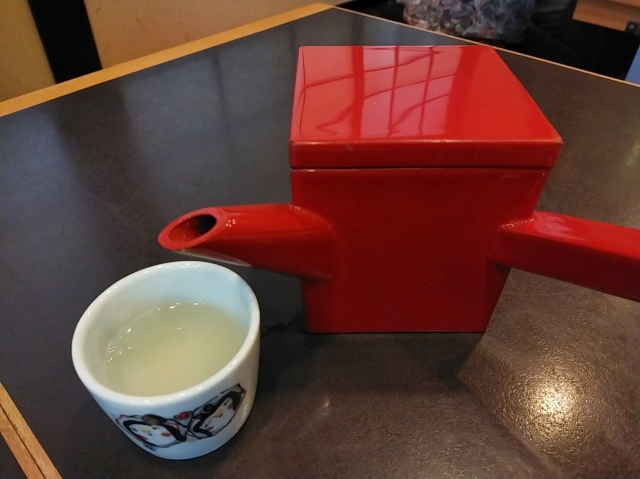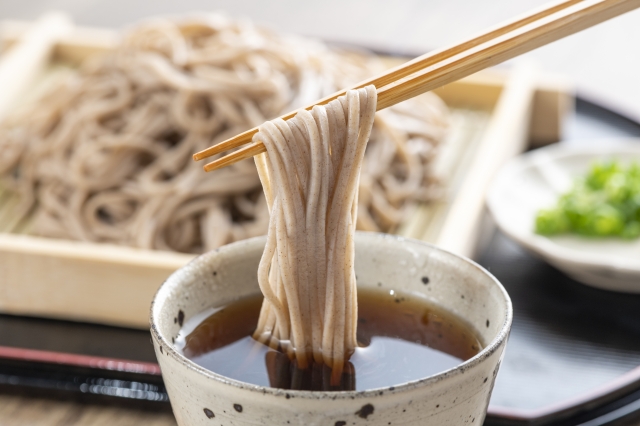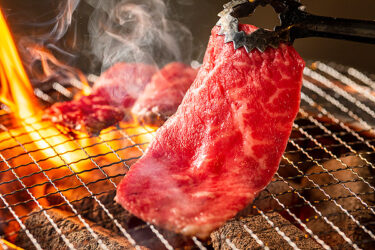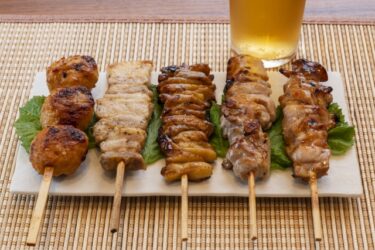Soba is made from buckwheat flour.
There are two types of buckwheat, “Zaru soba”, which is made from boiled buckwheat and then dipped in soy sauce-based soup, and “Kake soba”, which is eaten in warm soup.
Although it is typical, there are various ways to eat it all over Japan.
It is also an old fast food, and there are many standing-style soba restaurants on the premises of the train station. There is also cup noodle soba.
What is Soba and can I eat it?
Materials of Soba
Buckwheat flour, flour, salt
| Low FODMAPs | ||||
| for Vegetarian |
| Restaurant | Fast food | Food supermarket | Convenience store |
Various types of Soba
Buckwheat flour is gluten-free because it is made from buckwheat seed, which is a plant of the Polygonaceae family. Buckwheat flour has less starch than other grain flours, so if you make noodles with buckwheat flour alone, it will be less chewy and easier to cut, so wheat flour is usually added to the buckwheat flour.

Soba has been eaten in Japan for 9,000 years. It was in the 17th century that the current kind of noodles became popular with the general public, and there were many soba restaurants in the city of Tokyo.
The soba menu is divided into “cold soba” and “warm soba”. There are two types of cold soba. One is to eat noodles while dipping them in Tsuyu soup and the other is to eat noodles with Tsuyu soup. Warm soba contains soba in warm Tsuyu soup. Here are some typical ones.
Cold soba
- Zarusoba: Boiled soba chilled in water is placed on a bamboo colander and served. There is chopped seaweed on it. We eat soba with Tsuyu soup. Green onions, raw quail eggs, and wasabi may be added to the Tsuyu soup.
- Morisoba: Boiled soba chilled in water and served on a bamboo colander. Unlike Zarusoba, there is no chopped seaweed on it. We eat soba with Tsuyu soup and green onions, raw quail eggs, and wasabi may be added to the soup.
- Bukkake soba: Boiled soba chilled in water, placed on a dish and sprinkled with cold Tsuyu soup. There are the following types depending on the ingredients used.
- Oroshi soba: Bukkake soba with grated radish.
- Chilled Kitsune Soba: A bukkake soba topped with fried tofu that has been boiled sweet and spicy and cut into strips.
- Chilled Tanuki soba: A bukkake soba with tenkasu. Tenkasu is fried only tempura clothes.
Warm soba
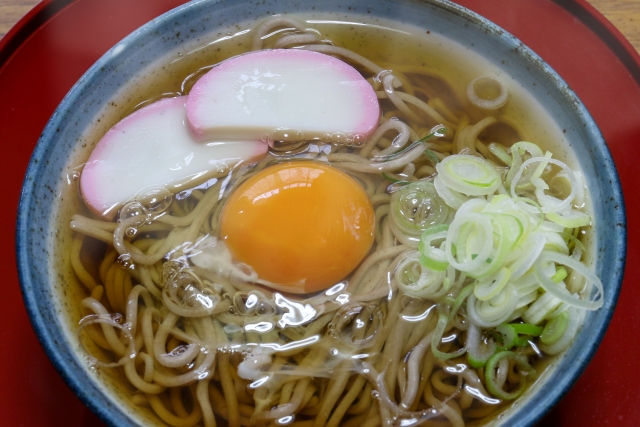
- Kake soba: Boiled soba is drained, put in a bowl, and sprinkled with warm Tsuyu soup. Only green onions other than soba and soup stock.
- Tsukimi soba: Kake soba with raw egg yolk. The name comes from the fact that the yolk looks like a full moon.
- Tempura soba: Kake soba with tempura on top. Prawn tempuras are used in high-end restaurants, but onions and small shrimp kakiage are often placed in popular stores.
- Kitsune soba: Kake soba topped with sweet and spicy fried tofu.
- Tanuki soba: Kake soba with tenkasu on top. Tenkasu is fried only tempura clothes. The cup noodle “Green Tanuki” is tempura soba with kakiage.
- Sansai soba: Kake soba topped with boiled edible wild plants. Wild plants are those harvested in the mountains, such as butterbur, bracken, royal fern, saku, mizu, armillaria, and bent bamboo shoots.
Buckwheat can also be categorized by the ratio of buckwheat flour to wheat flour contained in the noodles. - Nihachi Soba or Hachiwari Soba: Soba noodle made with 80% buckwheat flour and 20% wheat flour. It is said to have a good texture. Many of them are used by soba specialty restaurants.
- Juwari Soba: Soba made from 100% buckwheat flour without using binders. It is said that you can enjoy the taste and aroma of soba. Skill is needed to make noodles. Restaurants that offer 100% buckwheat noodles often indicate that it is “Juwari Soba”.
When served at a restaurant, the proportion of buckwheat flour contained in the noodles is not fixed. Stand-up soba restaurants in the station usually serve soba that uses more wheat flour than buckwheat flour. However, the low proportion of buckwheat flour does not mean that it is not delicious. I think people have different tastes.
Try to eat Soba!
How much ?
$ 2~15
Where can I eat Soba?
Soba restaurant (Sobaya)
Soba restaurants are everywhere in Japan, from urban areas to suburbs and rural areas. Many restaurants make noodles there, and you can eat delicious soba noodles. In particular, many soba restaurants in the countryside are particular about the ingredients and how to make them.
Soba shop (Tachigui-soba)
There are many soba restaurants inside and in front of railway stations, or in the food court of shopping centers. First of all, it is a system that purchases meal tickets at a vending machine, puts them out at the counter, and receives foods. When you finish eating, please return the tableware to the return port. The feature is that the price is low, there are many types, and it is quick from ordering to coming out.
Convenience stores or food supermarkets
You can buy cold soba lunch boxes at convenience stores and food supermarkets. The price is $ 3-4, and the noodles, green onions, and soba soup are included in the set. If you buy soba cup noodles and add hot water, you can eat warm soba. Cup noodles are quite different from soba, so if you want to eat warm soba, we recommend going to soba shops.
Precautions when eating Soba
For people who are gluten-free due to celiac disease, etc.
Most soba noodles contain wheat flour and should not be eaten. Since “Jyuwari-soba” or “Towari-soba” is made only from 100% buckwheat flour, it does not contain wheat flour, but wheat is used as the raw material for soy sauce. Gluten is broken down and almost no residue remains, so you should decide for yourself whether to eat “Jyuwari-soba”.
For Vegetalian
There are many soba menus that do not use animal ingredients. Tempura soba usually contains seafoods and Tsukimi soba contains egg.
Japanese writer’s comment for Soba
If you want to enjoy the taste of soba, I recommend going to a soba specialty restaurant and ordering Zarusoba or Morisoba. Before eating, please enjoy the fragrant aroma peculiar to soba. Then, soak it in Tsuyu soup and bring it to your mouth to enjoy the texture.
Welsh onions, seaweed, wasabi, etc. are available as condiments, so use them little by little to check the difference in taste.
“Sobayu” in a pot is prepared for you at a soba specialty restaurant. This is the juice from boiling soba.
When buckwheat noodle is boiled, the ingredients contained in the buckwheat will dissolve. Compared to pasta etc., the amount that melts out is large, so it is a drop. You can drink this as it is, or you can drink the same amount of soup and sobayu.
Sobayu is a service, so you will not be charged. If you order hot soba, sobayu will not be provided.
